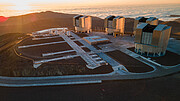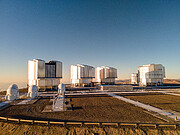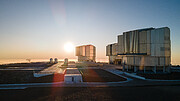Mededeling
25 jaar fantastische wetenschap en techniek met ESO’s Very Large Telescope
25 mei 2023
ESO’s Very Large Telescope (VLT), een van de meest geavanceerde optische telescopen ter wereld, viert vandaag zijn 25ste verjaardag. In het afgelopen tweeënhalve decennium heeft de VLT vanaf zijn thuisbasis in de Chileense Atacama-woestijn een grote impact gehad op ons begrip van het heelal, en diverse opmerkelijke primeurs afgeleverd.
De VLT is het vlaggenschip van de Europese optische astronomie op de grond. Hij bestaat uit vier vast opgestelde telescopen met hoofdspiegels met een diameter van 8,2 meter en vier verplaatsbare 1,8-meter hulptelescopen, die deel uitmaken van de VLT Interferometer. Op 25 mei 1998 maakte de eerste vaste telescoop, Antu, zijn eerste opnamen, waarmee een nieuw tijdperk voor de astronomie begon.
Sindsdien hebben astronomen op basis van gegevens die met de VLT-telescopen zijn verzameld meer dan tienduizend wetenschappelijke artikelen geproduceerd – gemiddeld meer dan één peer-reviewed artikel per dag. Enkele van de belangrijkste onderzoeken die met behulp van de VLT zijn gedaan, zijn het bestuderen van het superzware zwarte gat in het centrum van ons Melkwegstelsel en de bevestiging van de versnelde uitdijing van het heelal, die beide in Nobelprijzen hebben geresulteerd. Andere belangrijke resultaten zijn de eerste directe opname van een planeet buiten ons zonnestelsel en de karakterisering van de eerste zichtbare tegenhanger van een bron van zwaartekrachtstraling.
De opmerkelijke bijdragen van de VLT aan de wetenschap zijn te danken aan zijn geavanceerde instrumentenpakket. Een van de meest veelzijdige en populaire instrumenten binnen de astronomische gemeenschap is de FOcal Reducer and low dispersion Spectrograph (FORS), die met zeer hoge gevoeligheid opnamen kan maken van relatief grote stukken hemel. Met FORS zijn enkele van de meest iconische astronomische VLT-opnamen gemaakt. Een ander veelzijdig instrument is de Multi Unit Spectroscopic Explorer (MUSE), een krachtige spectrograaf waarmee astronomen 3D-beelden van het heelal kunnen maken. De VLT beschikt ook over X-shooter, waarmee een breed scala aan astronomische objecten kan worden waargenomen, zowel relatief zwakke als zeer heldere. Ook GRAVITY, een instrument van de VLT-interferometer, is bijzonder omdat deze het licht van vier telescopen samenvoegt en stabiliseert, waardoor astronomen uiterst kleine details in zeer zwakke objecten kunnen vastleggen.
Naast zijn veelzijdige instrumenten omvat de VLT een geavanceerd adaptief optisch systeem om de door atmosferische turbulentie veroorzaakte beeldonscherpte te corrigeren. Zijn viervoudige lasersysteem, dat op de vierde vaste telescoop (Yepun) is geïnstalleerd, wordt gebruikt om natriumatomen in de aardatmosfeer in aangeslagen toestand te brengen en is misschien wel het meest zichtbare onderdeel van het adaptieve optische systeem van de VLT. De aangeslagen atomen zenden licht uit dat door de atmosfeer op dezelfde manier wordt beïnvloed als het licht van echte sterren. Het uitgezonden licht wordt door de telescoop opgevangen en kan door het adaptieve optische systeem worden gebruikt om de door de atmosfeer veroorzaakte vervormingen te meten en vervolgens te corrigeren. In combinatie met de ongekend donkere hemel van de Atacama-woestijn, zorgt dit systeem ervoor dat de telescoop uiterst scherpe opnamen kan maken.
De VLT staat nog steeds aan het front van wetenschap en techniek en zal naar verwachting nog jarenlang belangrijke ontdekkingen blijven doen. Om dat te bewerkstelligen worden de vaste telescopen 1 t/m 3, als onderdeel van upgrades van het GRAVITY-instrument, momenteel voorzien van een laser-volgster.
ESO zal de verjaardag van de VLT deze week vieren op haar sociale mediakanalen, en ook de eerste aflevering van ESO’s nieuwe Chasing Starlight YouTube show staat in het teken van de meest opmerkelijke VLT-ontdekkingen.
Links
Contact
Bárbara Ferreira
ESO Media Manager
Garching bei München, Germany
Tel: +49 89 3200 6670
Email: press@eso.org
Over de Mededeling
| Id: | ann23009 |
Our use of Cookies
We use cookies that are essential for accessing our websites and using our services. We also use cookies to analyse, measure and improve our websites’ performance, to enable content sharing via social media and to display media content hosted on third-party platforms.
ESO Cookies Policy
The European Organisation for Astronomical Research in the Southern Hemisphere (ESO) is the pre-eminent intergovernmental science and technology organisation in astronomy. It carries out an ambitious programme focused on the design, construction and operation of powerful ground-based observing facilities for astronomy.
This Cookies Policy is intended to provide clarity by outlining the cookies used on the ESO public websites, their functions, the options you have for controlling them, and the ways you can contact us for additional details.
What are cookies?
Cookies are small pieces of data stored on your device by websites you visit. They serve various purposes, such as remembering login credentials and preferences and enhance your browsing experience.
Categories of cookies we use
Essential cookies (always active): These cookies are strictly necessary for the proper functioning of our website. Without these cookies, the website cannot operate correctly, and certain services, such as logging in or accessing secure areas, may not be available; because they are essential for the website’s operation, they cannot be disabled.
Functional Cookies: These cookies enhance your browsing experience by enabling additional features and personalization, such as remembering your preferences and settings. While not strictly necessary for the website to function, they improve usability and convenience; these cookies are only placed if you provide your consent.
Analytics cookies: These cookies collect information about how visitors interact with our website, such as which pages are visited most often and how users navigate the site. This data helps us improve website performance, optimize content, and enhance the user experience; these cookies are only placed if you provide your consent. We use the following analytics cookies.
Matomo Cookies:
This website uses Matomo (formerly Piwik), an open source software which enables the statistical analysis of website visits. Matomo uses cookies (text files) which are saved on your computer and which allow us to analyze how you use our website. The website user information generated by the cookies will only be saved on the servers of our IT Department. We use this information to analyze www.eso.org visits and to prepare reports on website activities. These data will not be disclosed to third parties.
On behalf of ESO, Matomo will use this information for the purpose of evaluating your use of the website, compiling reports on website activity and providing other services relating to website activity and internet usage.
Matomo cookies settings:
Additional Third-party cookies on ESO websites: some of our pages display content from external providers, e.g. YouTube.
Such third-party services are outside of ESO control and may, at any time, change their terms of service, use of cookies, etc.
YouTube: Some videos on the ESO website are embedded from ESO’s official YouTube channel. We have enabled YouTube’s privacy-enhanced mode, meaning that no cookies are set unless the user actively clicks on the video to play it. Additionally, in this mode, YouTube does not store any personally identifiable cookie data for embedded video playbacks. For more details, please refer to YouTube’s embedding videos information page.
Cookies can also be classified based on the following elements.
Regarding the domain, there are:
- First-party cookies, set by the website you are currently visiting. They are stored by the same domain that you are browsing and are used to enhance your experience on that site;
- Third-party cookies, set by a domain other than the one you are currently visiting.
As for their duration, cookies can be:
- Browser-session cookies, which are deleted when the user closes the browser;
- Stored cookies, which stay on the user's device for a predetermined period of time.
How to manage cookies
Cookie settings: You can modify your cookie choices for the ESO webpages at any time by clicking on the link Cookie settings at the bottom of any page.
In your browser: If you wish to delete cookies or instruct your browser to delete or block cookies by default, please visit the help pages of your browser:
Please be aware that if you delete or decline cookies, certain functionalities of our website may be not be available and your browsing experience may be affected.
You can set most browsers to prevent any cookies being placed on your device, but you may then have to manually adjust some preferences every time you visit a site/page. And some services and functionalities may not work properly at all (e.g. profile logging-in, shop check out).
Updates to the ESO Cookies Policy
The ESO Cookies Policy may be subject to future updates, which will be made available on this page.
Additional information
For any queries related to cookies, please contact: pdprATesoDOTorg.
As ESO public webpages are managed by our Department of Communication, your questions will be dealt with the support of the said Department.








